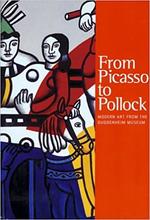More about Lyubov' Popova
- All
- Info
- Shop
Works by Lyubov' Popova

Sr. Contributor
Lyubov Popova was one of the coolest Russian Communist artists of her time.
Before committing herself to the Communist goals of the Russian Revolution, Popova explored the Western world. She traveled to France and Italy, where she saw works by artists like Umberto Boccioni in Italy and Fernand Léger in France. Futurism and Cubism were quickly becoming the artistic styles of the future, and Popova was catching on fast.
Popova was only able to see great art abroad because of her wealthy parents...but don’t let Vladimir Lenin know that. After returning to Russia in 1916, she joined the Supremus group, which was organized by Kazimir Malevich. Malevich and friends began creating really exciting paintings of literally just squares and other abstract forms. These dabblings in the avant-garde brought her ever closer to the sweet embrace of Communism.
While Kandinsky was creating fluttery, colorful compositions, Popova was forging constructions and effectively testing the boundaries of art itself. She quickly gained acclaim as one of the great women artists of Russian Constructivism. Yes, that’s right. I said a woman artist who actually got noticed and appreciated for her work during her own lifetime! Fortunately, Popova doesn’t share the same type of story as other women artists like Artemisia Gentileschi, who waited centuries to earn her rightful place in the narrative of art history.
Popova’s good fortune actually resulted from the advent of Communism. After the revelation of the October Revolution, Russia granted equal rights to women. They were the first nation to do this. Who knew? Communism continued to shape the direction of Popova’s art. As Communism gained momentum, Lenin decided that great art would serve a utilitarian function, and his loyal artist-followers happily complied. That’s all it took. Popova, among many others, declared painting obsolete. Instead, she designed costumes and stage sets for plays meant to sway the masses toward the Red party.
A different sort of red cut her successful career short. In 1924, Popova died at the young age of thirty-five – four days after a bout of scarlet fever claimed her son’s life. Perhaps this was for the best, though. Shortly after her death, Lenin fell from power, and Communist art fell out of favor. To remain relevant, all of Popova’s old colleagues started to produce art in the social realist style. What a bunch of sellouts.
Sources
- Adaskina, Natalia, and Dmitri Sarabianov. “Liubov Popova.” In Amazons of the Avant-Garde. Edited by Alexandra Exter, JohnE. Bowlt, and Matthew Drutt. New York: Solomon R. Guggenheim Foundation, 2000.
- Kozloff, Joyce. “Liubov Popova, an Homage.” Hyperallergic. https://hyperallergic.com/263445/liubov-popova-an-homage/. Accessed October 17, 2017.
- Smith, Roberta. “The Russian Avant-Garde Rising in ‘A Revolutionary Impulse.’” The New York Times. December 8, 2016. https://www.nytimes.com/2016/12/08/arts/design/the-russian-avant-garde-…. Accessed October 17, 2017.
- Solomon R. Guggenheim Foundation. “Liubov Popova.” Collection Online. https://www.guggenheim.org/artwork/artist/liubov-popova. Accessed October 8, 2017.
- Solomon R. Guggenheim Foundation. “Untitled.” Collection Online. https://www.guggenheim.org/artwork/3494. Accessed October 17, 2017.
- The Guerrilla Girls. The Guerrilla Girls’ Bedside Companion to the History of Western Art. New York: Penguin Books, 1998.
Featured Content
Here is what Wikipedia says about Lyubov Popova
Lyubov Sergeyevna Popova (Russian: Любо́вь Серге́евна Попо́ва; April 24, 1889 – May 25, 1924) was a Russian-Soviet avant-garde artist, painter and designer.
Check out the full Wikipedia article about Lyubov Popova


















